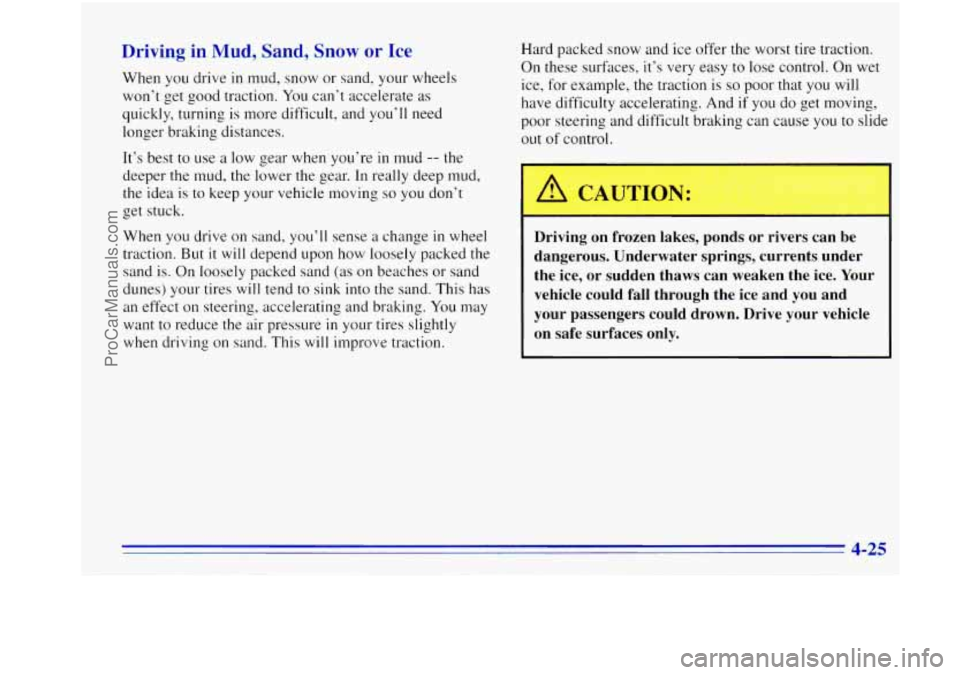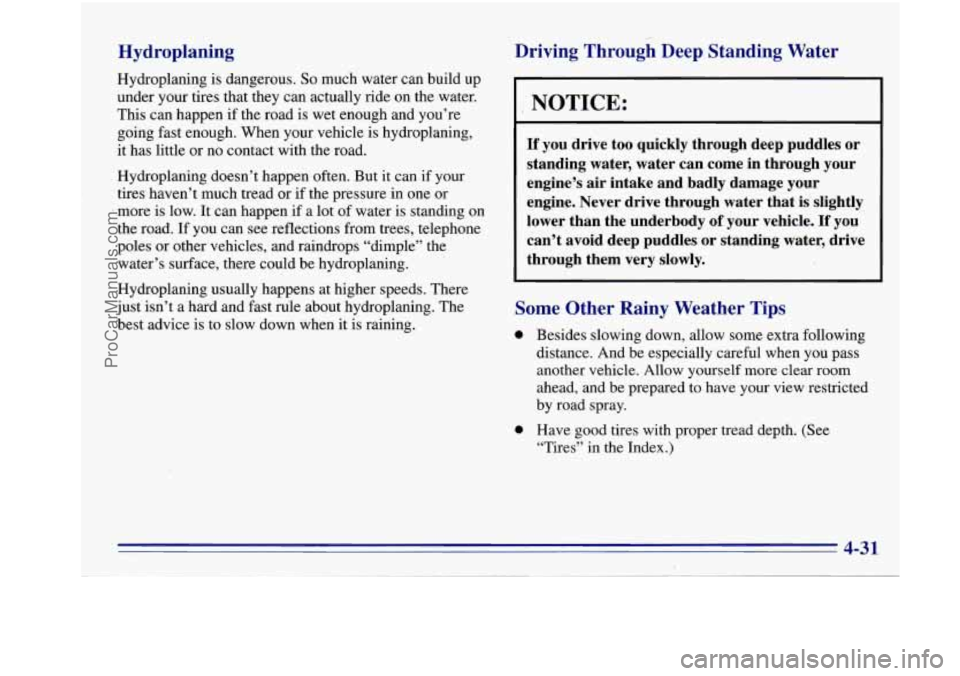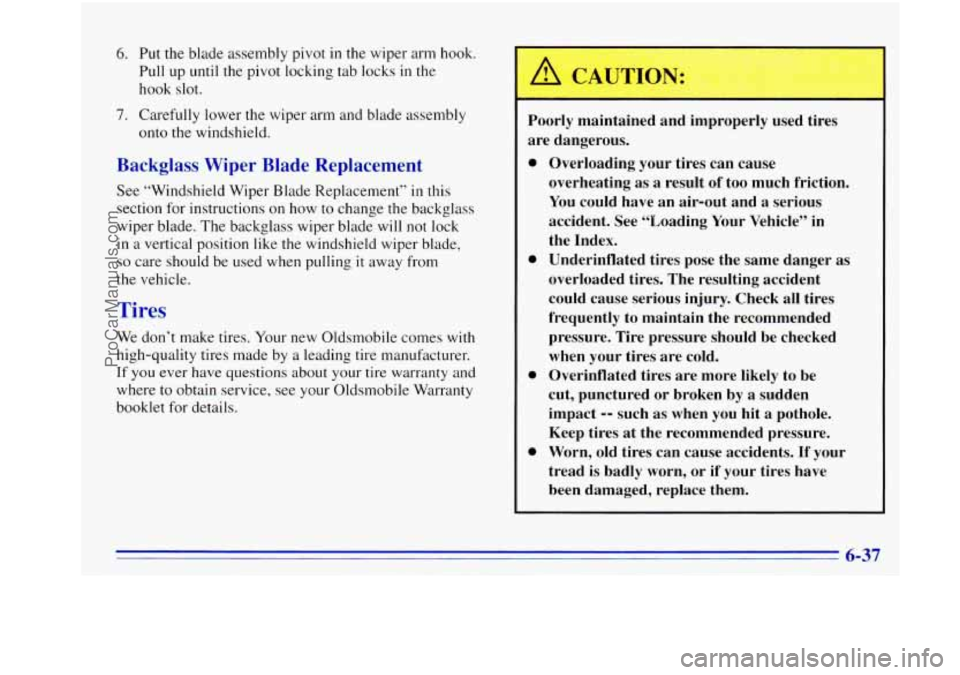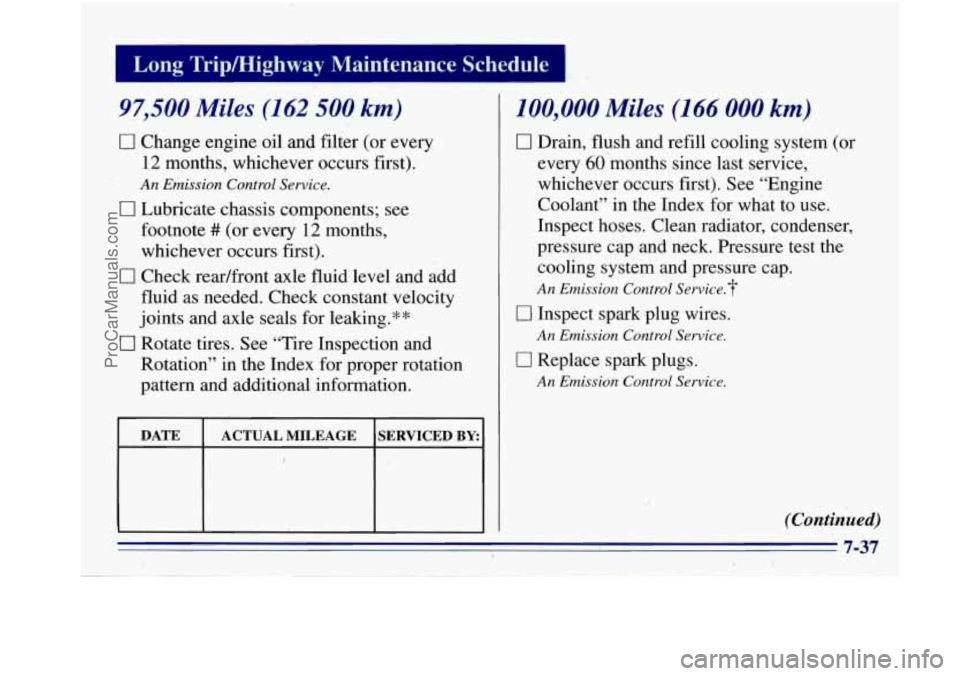tire pressure OLDSMOBILE BRAVADA 1996 Owners Manual
[x] Cancel search | Manufacturer: OLDSMOBILE, Model Year: 1996, Model line: BRAVADA, Model: OLDSMOBILE BRAVADA 1996Pages: 340, PDF Size: 17.49 MB
Page 135 of 340

I
Here's how anti-lock works. Let's say the road is wet.
You're driving safely. Suddenly an animal jumps out
in
front of you.
You slam on the brakes. Here's what happens with ABS.
A computer senses that wheels are slowing down. If one
of the wheels
is about to stop rolling. the computer will
separately work the brakes at each front wheel and at the
rear wheels. The
anti-lock system can change the brake pressure faster
than
any driver could. The computer is programmed to
make the most of available tire and road conditions.
You can steer around the obstacle while braking hard.
As you brake, your computer keeps receiving updates on
wheel speed and controls braking pressure accordingly.
4-7
ProCarManuals.com
Page 153 of 340

Driving in Mud, Sand, Snow or Ice
When you drive in mud, snow or sand, your wheels
won’t get good traction.
You can’t accelerate as
quickly, turning is more difficult, and you’ll need
longer braking distances.
It’s best
to use a low gear when you’re in mud -- the
deeper the mud, the lower the gear. In really deep mud,
the idea
is to keep your vehicle moving so you don’t
get stuck.
When you drive on sand, you’ll sense a change in wheel
traction. But
it will depend upon how loosely packed the
sand is. On loosely packed sand
(as on beaches or sand
dunes) your tires will tend to sink into the sand. This has
an effect on steering, accelerating and braking. You may
want to reduce
the air pressure in your tires slightly
when driving on sand. This
will improve traction. Hard packed snow and
ice offer the worst tire traction.
On these surfaces, it’s very easy to lose control. On wet
ice, for example, the traction is
so poor that you will
have difficulty accelerating. And if
you do get moving,
poor steering and difficult braking can cause
you to slide
out
of control.
1
A CAUl
Driving on frozen lakes, ponds or rivers can be
dangerous. Underwater springs, currents under
the ice, or sudden thaws can weaken the ice. Your
vehicle could fall through the ice and you and
your passengers could drown. Drive your vehicle
on safe surfaces only.
4-25
ProCarManuals.com
Page 159 of 340

Hydroplaning
Hydroplaning is dangerous. So much water can build up
under your tires that they can actually ride on the water.
This can happen if the road is wet enough and you’re
going fast enough. When your vehicle is hydroplaning,
it has little or no contact with the road.
Hydroplaning doesn’t happen often. But
it can if your
tires haven’t much tread or if the pressure in one or
more is low. It can happen if a lot of water is standing on
the road. If you can see reflections from trees, telephone
poles or other vehicles, and raindrops “dimple” the
water’s surface, there could be hydroplaning.
Hydroplaning usually happens at higher speeds. There
just isn’t a hard and fast rule about hydroplaning. The
best advice is to slow down when it is raining.
Driving Through Deep Standing Water
NOTICE:
If you drive too quickly through deep puddles or
standing water, water can come in through your
engine’s air intake and badly damage your
engine. Never drive through water that is slightly
lower than the underbody
of your vehicle. If you
can’t avoid deep puddles
or standing water, drive
through them very slowly.
Some Other Rainy Weather Tips
0 Besides slowing down, allow some extra following
distance. And be especially careful when you pass
another vehicle. Allow yourself more clear
room
ahead, and be prepared to have your view restricted
by road spray.
“Tires” in the Index.)
0 Have good tires with proper tread depth. (See
4-31
ProCarManuals.com
Page 162 of 340

The exit speed is usually posted.
Reduce your speed according
to your speedometer, not
to your sense of motion. After driving for any distance
at higher speeds,
you may tend to think you are going
slower than you actually are.
Before Leaving on a Long Trip
Make sure you’re ready. Try to be well rested. If you
must start when you’re not fresh
-- such as after a day’s
work
-- don’t plan to make too many miles that first part
of the journey. Wear comfortable clothing and shoes you
can easily drive
in.
Is your vehicle ready for a long trip? If you keep it
serviced and maintained, it’s ready to go. If it needs
service, have
it done before starting out. Of course,
you’ll find experienced and able service experts in
Oldsmobile retailers all across North America. They’ll
be ready and willing to help
if you need it.
Here are some things you can check before a trip:
0
0
0
0
0
0
0
Windshield Washer Fluid: Is the reservoir full? Are
all windows clean inside and outside?
Wiper Blades: Are they in good shape?
Fuel, Engine Oil, Other Fluids: Have you checked
all levels?
Lamps: Are they all working? Are the lenses clean?
Tires: They are vitally important to a safe,
trouble-free trip.
Is the tread good enough for
long-distance driving? Are
the tires all inflated to the
recommended pressure?
Weather Forecasts: What’s the weather outlook
along your route? Should you delay your trip
a short
time
to avoid a major storm system?
Maps: Do you have up-to-date maps?
ProCarManuals.com
Page 169 of 340

Loading Your Vehicle
GVWR GAWR FRT GAWR RR A IU
II 111
1
I
< SEE OWNER’S MANUAL FOR ADDITIONAL - INFORMA TlON
The CertificatiodTire label is found on the driver’s door
edge, above the door latch. The label shows the size of
your original tires and the inflation pressures needed
to
obtain the gross weight capacity of your vehicle. This is
called the GVWR (Gross Vehicle Weight Rating). The
GVWR includes the weight of the vehicle, all occupants,
fuel, cargo and trailer tongue weight, if pulling a trailer.
The CertificatiodTire label also tells you the maximum
weights for the front and rear axles, called Gross Axle
Weight Rating (GAWR). To find out the actual loads on
your front and rear axles, you need to go to a weigh
station and weigh your vehicle. Your retailer can help
you with this. Be sure to spread out your load equally on
both sides of the centerline. Never exceed
the GVWR for your vehicle, or the Gross
Axle Weight Rating (GAWR) for either the front or
rear axle.
If you do have a heavy load, you should spread it out.
Similar appearing vehicles may have different GVWR’s
and payloads. Please note your vehicle’s
Certificatioflire label or consult your retailer for
additional details.
I A CAUTION:
Do not load your vehicle any heavier than the
GVWR, or either the maximum front or rear
GAWR. If you do, parts on your vehicle can break,
or it
can change the way your vehicle handles.
These could
cause you to lose control. Also,
overloading can shorten the life of your vehicle.
I
4-41
ProCarManuals.com
Page 249 of 340

6. Put the blade assembly pivot in the wiper arm hook.
Pull up until the pivot locking tab locks
in the
hook slot.
7. Carefully lower the wiper arm and blade assembly
onto the windshield.
Backglass Wiper Blade Replacement
See “Windshield Wiper Blade Replacement” in this
section for instructions
on how to change the backglass
wiper blade. The backglass wiper blade
will not lock
in
a vertical position like the windshield wiper blade,
so care should be used when pulling it away from
the vehicle.
Tires
We don’t make tires. Your new Oldsmobile comes with
high-quality tires made by
a leading tire manufacturer.
If you ever have questions about your tire warranty and
where to obtain service, see your Oldsmobile Warranty
booklet for details. Poorly maintained and improperly used tires
are dangerous.
0
0
0
0
Overloading your tires can cause
overheating as a result
of too much friction.
You could have an air-out and a serious
accident. See “Loading Your Vehicle” in
the Index. Underinflated tires pose the same danger as
overloaded tires. The resulting accident
could cause serious injury. Check all tires
frequently to maintain the recommended
pressure. Tire pressure should be checked
when your tires are cold.
Overinflated tires are more likely to be
cut, punctured or broken by a sudden
impact
-- such as when you hit a pothole.
Keep tires at the recommended pressure.
Worn, old tires can cause accidents.
If your
tread is badly worn, or if your tires have
been damaged, replace them.
6-37
ProCarManuals.com
Page 250 of 340

Inflation -- Tire Pressure . ..
The Certificatioflire label; which is on the driver’s
door edge, above the door latch,
shows the correct
inflation pressures for your tires when they’re cold.
“Cold” means your vehicle. has been sitting for at least
three hours or driven no more
than- 1 mile (1.6 km).
NOTICE:
~~
.Don’t let anyone tell you that underinflation or
overinflation
is all right. It’s not. If your tires
don’t have enough
air (underinflation), you can
get the following:
0 Too much flexing
Too much heat
0 Tire overloading
0 Bad wear ’ ,
0 , Bad handling
0 Bad fuel economy.
NOTICE: (Continued)
,. ..
.N,OTICE:’ (Continued)
If your tires have too much air (overinflation),
you can get the following:
0 Unusual wear
0 Bad handling
0 Rough ride .
0 Needless damage from road hazards.
When to Check
Check your tires once a month or more. Also, check the
tire pressure
of the spare tire.
How to Check
Use a good quality pocket-type gage to check tire
pressure. You can’t tell
if your tires are. properly inflated
simply by looking at them. Radial tires may look
properly inflated even when they’re underinflated.
Be sure to put the valve caps,back on the valve stems.
They help prevent leaks by keeping out
dirt and moisture.
ProCarManuals.com
Page 251 of 340

Tire Inspection and Rotation
Tires should be inspected every 6,000 to 8,000 miles
(I 0 000 to 13 000 km) for any signs of unusual wear.
If unusual wear is present, rotate your tires as soon
as
possible and check wheel alignment. Also check for
damaged tires or wheels. See “When It’s Time for New
Tires” and “Wheel Replacement” later
in this section for
more information.
The purpose of regular rotation
is to achieve more
uniform wear for all tires on the vehicle. The first
rotation is the most important. See “Scheduled
Maintenance Services”
in the Index for scheduled
rotation intervals. When rotating your tires,
always use the correct rotation
pattern shown here.
After the tires have been rotated, adjust the front and
rear inflation pressures as shown on the CertificatiodTire
label. Make certain that all wheel nuts are properly
tightened. See “Wheel Nut Torque”
in the Index.
Rust or dirt on a wheel, or on the parts to which
it is fastened, can make wheel nuts become loose
after a time. The wheel could come off and cause
an accident. When you change
a wheel, remove
any rust or dirt from places where the wheel
attaches to the vehicle. In an emergency, you can
use
a cloth or a paper towel to do this; but be
sure to use a scraper
or wire brush later, if you
need to, to get all the rust or dirt off. (See
“Changing
a Flat Tire” in the Index.)
6-39
ProCarManuals.com
Page 269 of 340

Capacities and Specifications
Engine Description ............ “VORTEC” 4300
Type
.................................... V6
VINCode
................................. W
Firing Order
...................... 1-6-5-4-3-2
Horsepower
................... 190 at 4,400 rpm
Thermostat Specification
........... 195°F (9 1 “C)
Spark Plug Gap
.......... 0.045 inches (0.114 cm)
Wheels and Tires
Wheel Nut Torque ............ 95 Ib-ft (1 30 Nem)
Tire Pressure ...................... Look at the
CertificatiodTire label.
See “Loading Your Vehicle” in
the Index.
Normal Maintenance Replacement Parts
Replacement part numbers listed in this section are
based on the latest information available at the time of
printing, and are subject to change.
If a part listed in this
manual is not the same as the part used in your vehicle
when
it was built, or if you have any questions, please
contact your retailer.
Oil Filter..
............................. PF52
Air Cleaner Filter
...................... A 1 163C
PCV Valve
.......................... CV746C
Automatic Transmission Filter
Kit ...... 24200796
Spark Plugs
.......................... .41-932
Fuel Filter
............................. GF48 1
Windshield Wiper Blade
, . Trico (20 inched50.8 cm) .
Backglass Wiper Blade ... Trico (14 inched35.6 cm)
6-57
ProCarManuals.com
Page 307 of 340

97,500 Miles (162 500 km)
0 Change engine oil and filter (or every
12 months, whichever occurs first).
0 Lubricate chassis components; see
footnote
# (or every 12 months,
whichever occurs first).
0 Check readfront axle fluid level and add
fluid as needed. Check constant velocity
joints and axle seals for leaking.**
0 Rotate tires. See “Tire Inspection and
Rotation’’ in the Index for proper rotation
pattern and additional information.
An Emission Control Service.
,.
ACTUAL MILEAGE SERVICED BY:
I
100,000 Miles (166 000 km)
0 Drain, flush and refill cooling system (or
every 60’months since last service,
whichever occurs first). See “Engine
Coolant” in the Index for what to use.
Inspect hoses. Clean radiator, condenser,
pressure cap and neck. Pressure test the
cooling system and pressure cap.
An Emission Control Service.Jf
0 Inspect spark plug wires.
0 Replace spark plugs.
An Emission Control Service.
An Emission Control Service.
(Continued)
ProCarManuals.com